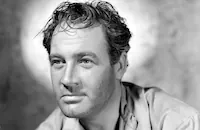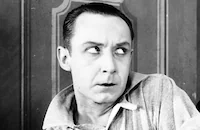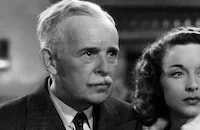To Mary--With Love
Brief Synopsis
Cast & Crew
John Cromwell
Warner Baxter
Myrna Loy
Ian Hunter
Claire Trevor
Jean Dixon
Film Details
Technical Specs

Synopsis
In October 1935, New York attorney William C. Hallam has his secretary send some flowers to Mary Wallace. He begins to write on the card, "To Mary," then thinks back to October 1925, on election night, as a huge party is underway at the Waldorf-Astoria Hotel for Jimmy Walker, New York's newly elected mayor. Newlyweds Mary and John "Jock" Wallace, an architect, celebrate with Bill, their friend and best man, and after they meet a pretty young woman, Kitty Brant, they all drink champagne while discussing Jock and Mary's honeymoon cruise to Europe. The couple have a wonderful time in Paris, and Kitty and Bill meet them at the dock on their return. In 1926, in Philadelphia, at the Dempsey-Tunney fight, Jock tells Bill that he's going to make a million dollars investing in real estate, and Bill reminds Jock of his dream of starting a renaissance in American architecture, and that he, Bill, is the one who is more interested in money. On the train back to the city, Bill and Kitty are having fun, but Jock, who is working too hard, and Mary, who wants a baby, are fighting. Mary asks Jock to go with her to a house party in Maine, and when he refuses, she goes alone and does not reappear for ten days. She finds Kitty's compact in the apartment and threatens to leave, but Jock pleads and she stays. In 1927, while watching the Lindbergh parade from Jock's real estate office windows, Jock reveals his plans to open a casino club in Long Island, using all his money to get it started. Mary, now pregnant, asks Bill when he will marry, but he replies that he hasn't found the right girl. The baby dies at birth, and Mary, devastated, goes to Bermuda to recuperate. Jock is too busy to accompany her. After Jock makes a lot of money on the stock exchange, the couple move to Park Avenue. In 1929, at a party at the apartment, Bill, disgusted by the sycophants, gossipers and leeches, is surprised to meet a very nice woman, Irene Potter, who owns a candy shop on Madison Avenue. As Bill berates Mary for her decadent lifestyle, Jock enters with news of the stock market crash. Jock is financially ruined, and the couple move into a cheap bungalow. Irene offers Mary a job in her candy store, but Jock is too proud to let his wife work. When Mary sees Jock, who now drinks heavily, accept a check from Bill, she goes to work at the candy store. When Bill lectures Jock on his responsibilities, Jock responds by punching Bill, but he is immediately sorry. On Christmas, Jock is working at "Bloomfield's," while Bill and Mary prepare a modest celebration. However, Jock receives a termination notice in his paycheck, and he goes to a bar to drown his sorrows, where he happens to meet Kitty Brant. They drink and dance the night away, while Bill confesses his love for Mary, who is ambivalent. When a taxi driver arrives at the house and tells them that Jock has been in a serious auto accident, they rush to the hospital, only to discover that the other passenger in the car was Kitty. As Jock recovers in a nursing home, he receives a letter offering him the job of managing the casino club he once wanted to own. Jock promises Mary that everything will be fine, but she is not so sure. At a big dinner at the casino club, Jock talks of big plans for expansion. Bill tells Mary that Jock has had an offer to build a model housing community in the Tennessee Valley, but Jock wants to get rich again. Mary wants to divorce Jock, but Bill gets them together and reminds them of all they have been through. Because of Bill, Jock decides to take the job in Tennessee. Back in the present, Bill finishes writing the card he began, "To Mary," with the words, "with love."

Director

John Cromwell
Cast

Warner Baxter

Myrna Loy

Ian Hunter

Claire Trevor

Jean Dixon
Pat Somerset
Helen Brown
Wedgewood Nowell
Harold Foshay
Paul Hurst

Franklin Pangborn
Tyler Brooke
Arthur Aylesworth
Florence Lake
Edward Cooper
Margaret Fielding
Ruth Clifford
Louise Lorimer
Jean Houghton
Margaret Brayton
Edwin Maxwell
Grace Goodall
Beth Hazelton
Eddie Dunn
Tom Mcguire
Tom Ricketts
Tammany Young
Niles Welch
Richard Powell
Frank O'connor
William Taylor Stelling
Virginia Paxton
William Cromwell
Eric Wilton
Jay Eaton
Phyllis Barry
Evelyn Barlow
Geneva Sawyer
Paul Mcvey
Richard Barbee

Howard C. Hickman
Frances Paxton
Carlyle Blackwell Jr.
Daisy Bufford
Matt Mchugh

Irving Bacon
Mario Dominici
Jean De Briac
Lawrence Wheat
James Cane
Crew
Harry Brand
William Darling
Ralph Dietrich
A. F. Erickson
Roger Heman
Mark-lee Kirk
Thomas Little
Kenneth Macgowan
William Murphy
Royer
Richard Sherman
Louis Silvers
Howard Ellis Smith
Sidney Wagner
E. Clayton Ward
Jack Wells
Darryl F. Zanuck

Film Details
Technical Specs

Quotes
Trivia
Notes
The plot summary was based on a screen continuity in the Twentieth Century-Fox Produced Scripts Collection at the UCLA Theater Arts Library. According to Variety, the film includes newsreel footage of "such episodes as Jimmy Walker's election, the [Gene] Tunney-[Jack] Dempsey fight, [Charles A.] Lindbergh's reception, [President Calvin] Coolidge's 'I-do-not-choose,' the Wall Street egg-laying, etc." Lib noted that the newsreel shots were "projected on an enormous screen background while players act in front," and that this technique was new to films. Relating the film to Cavalcade, Fox's 1933 drama following a British family from the turn-of-the-century to the present, Variety comments that this film is "a cavalcade, but without sweep and without moral. It throws no light either on the background it plays up or on the two main characters." Lib credited William Darling, Twentieth Century-Fox's head art director, with the modeling of two gargoyles. According to the copyright music listings, the song, "To Mary-With Love," by Mack Gordon and Harry Revel, was written for the production; however, the song does not appear in the screen continuity. It is possible that it is sung or played during the credit sequence. New York Times notes that Irving Berlin's "Remember" was used in the score as a musical motif. Margaret Bloodgood is listed as a cast member in Hollywood Reporter production charts, but her participation in the final film has not been confirmed.












